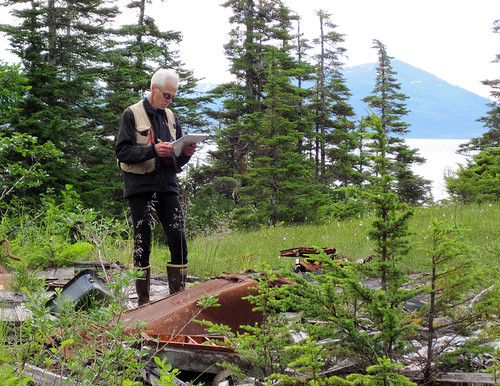
Vegetation ecologists play an essential role in the U.S. Forest Service. They research the abundance and location of flora in their region as well as the factors that influence how the plants flourish. All nine Forest Service regions and most forests have ecologists on staff, representing a variety of interests. Some ecologists are fascinated by fungi, while others focus on lichens, wildflowers and other elements of biodiversity. In addition, plant ecologists and botanists provide quite a bit of support to the other disciplines and program areas within the Forest Service.
Robert L. DeVelice, a vegetation ecologist on the Chugach National Forest, fits the role well. His wealth of education, experience and personal interests have benefited both the forest and the local community. He grew up in New Mexico, received a Bachelor of Science in forestry from the University of Montana, a Masters in agronomy with a focus on forest soils from New Mexico State University, and a Ph.D. in plant ecology. When he arrived in Alaska in 1992, he was quite interested in native plants, their distribution and ecological occurrences across the landscape.
“I always had an appreciation of natural landscapes,” DeVelice said. “There was always a big attraction in coming to Alaska because I knew the forests here, especially on the Chugach, were primarily driven by natural processes.”
DeVelice said that the occurrence of non-native plant species in Alaska is fairly rare, and the plants are restricted in their distribution across the landscape. For this reason, Alaska is an exceptional place to see vegetation in its primarily natural process-driven state.
The 5.4-million-acre Chugach National Forest, the second-largest single forest in the nation, has a diversity of environments that range from rainforest to interior forest to wetlands. This richness produces abundant botanical life.
“For example, the Prince William Sound area contains spectacular glaciers and huge variety of temperate rainforest vegetation types,” said DeVelice. “The Kenai Peninsula has a flavor more similar to the boreal sections of Interior Alaska, with vegetation that includes trees like aspen that are not common elsewhere on the Chugach. The Copper River Delta, on the other hand, contains a rich array of wetland vegetation.”
DeVelice developed a hierarchal vegetation classification for mapping and describing biodiversity across the landscape. The project was started 1988 by his predecessor (Susan L. Boudreau) who conducted plant sampling on Montague Island in Prince William Sound. Since then, DeVelice and his colleagues have sampled over 2,000 ocular macro plots.
In the 2,000 plots that were established on the Chugach, over 500 plant species were represented. That is one-third of the whole flora of the State of Alaska, which is indicative of the diversity and richness of the area.
When asked what he considers to be one of his most important contributions as a vegetation ecologist, DeVelice refers to “Assessing the extent to which roadless areas complement the conservation of biological diversity” published in the prestigious journal Ecological Applications.
The work assesses the contribution that inventoried roadless areas on National Forest System lands could make toward building a representative network of conservation reserves in the United States. Including roadless areas expands representation of a range of ecological conditions, increases the area of reserves at lower elevations, and increases the number of areas large enough to provide refugia for species needing large tracts relatively undisturbed by people.
While DeVelice has made significant contributions to ecology research for the Forest Service, one of his favorite pastimes is bringing his love of native flora to the community at large. Last year, he led the Botany Challenge 49 on the Falls Creek Trail 20 miles east of Anchorage. This area adjacent to the Seward Highway has quite a high diversity of plants. The goal for the hikers was to locate 49 species of plants (in honor of Alaska being the 49th state) within two hours. Their trip started at sea level and ended at an elevation of 1,200 feet.
“The Falls Creek area is immensely beautiful and includes verdant forests, species rich shrublands, and a lively stream,” said DeVelice.
Sometimes DeVelice’s community outings are as simple as nature walks with kids to look for leaves. Other outings are much more strenuous.
DeVelice is an avid runner and rock climber. He ran the Western States 100-Mile Endurance Run in California 11 times. He also leads local epic runs that last from two to four hours. Established in 2000, these events are non-competitive training runs that take the athletes through rugged terrain, thick vegetation, and even Southcentral Alaska’s bitter winter weather.
In addition to his professional and social advocacy for the botanical riches of Alaska, DeVelice’s love for wildflowers reaches a personal level. He and his wife Jeannie named their daughter Linnaea after his favorite flower, Linnaea borealis, or twinflower. Carolus Linnaeus, for which the flower was named, is considered the father of binomial nomenclature for plants.
Through his various endeavors, DeVelice ensures his passion and knowledge are shared with future generations who will become the next stewards of the natural resources that he loves.
